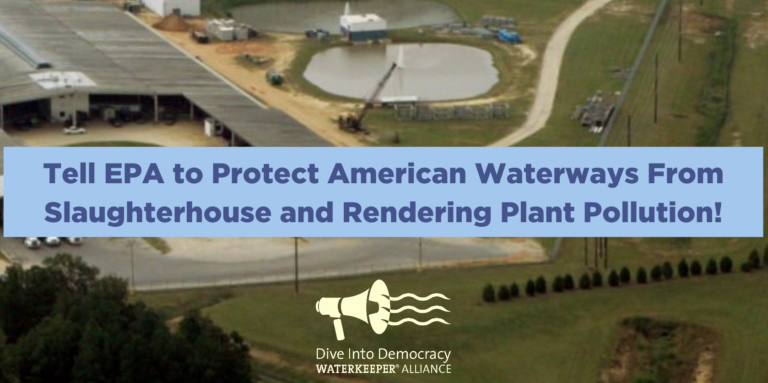Tell EPA to Protect American Waterways From Slaughterhouse and Rendering Plant Pollution!
By: Thomas Hynes

The U.S. Environmental Protection Agency (EPA) recently announced a proposed rule to establish new water pollution control standards for slaughterhouses and rendering facilities discharging waste into U.S. rivers, lakes, and streams, a leading cause of the nitrogen and phosphorus pollution that fuels toxic algal blooms and “dead zones” throughout the country. These devastating events can render water unsafe for drinking, unfit for recreation, and uninhabitable for aquatic life. It is time for EPA to step up and protect our communities and waterways from these preventable disasters.
That is why we are calling on the agency to act immediately and thoroughly protect public health and the environment from all of these ongoing threats.
Will you join us in urging EPA to finalize the most strident discharge standards for slaughterhouses and rendering plants?
The Clean Water Act requires EPA to set water pollution standards for all industries and to review those standards every year in order to determine whether updates need to be made to reflect advances in pollution-control technology. Despite this clear mandate, EPA failed to update standards for slaughterhouses and rendering plants for nearly 20 years and is only doing so now in response to lawsuits filed on behalf of Waterkeeper Alliance, Waterkeepers Chesapeake, Cape Fear Riverkeeper, and seven other groups by the Environmental Integrity Project and Earthjustice.
Incredibly, EPA is currently proposing, as its preferred option, to cut pollution significantly from 126 of the largest plants that pipe their waste directly into waterways, but to largely ignore the 3,708 indirectly discharging plants that send their waste to municipal sewage treatment plants, which are often overwhelmed and not equipped to treat this industrial waste. This approach will allow the industry to continue either polluting waterways or passing their treatment expenses off to impacted communities and citizens that cannot, and should not, bear those costs.
Federal regulations that currently control water pollution from slaughterhouses and rendering facilities are either out-of-date, poorly enforced, or simply non-existent. Some facilities are still subject to standards established in the mid-1970s. None of the existing regulations limit discharges of phosphorus—even though slaughterhouses and rendering facilities discharge more phosphorus into the nation’s waters than any other industry. Even more concerning, the EPA has never published national standards applicable to the vast majority of slaughterhouses and rendering facilities, which discharge wastewater through sewage treatment plants, even though the EPA has known for decades that—without adequate pretreatment—pollutants in slaughterhouse wastewater pass through many treatment plants into our nation’s rivers and streams.
EPA has proposed a variety of solutions to this problem. It is imperative that we let them know that only the most protective option will suffice.
That most protective option (Option 3), which is not what the agency prefers to do, would place limits on 133 direct dischargers and would also limit nitrogen, phosphorus, and other harmful pollution from an estimated 1,485 facilities that discharge to municipal sewage treatment plants. These indirect dischargers have gotten a free pass to pollute for decades, pushing either their pollution or waste management expenses off on the public that cannot, and should not, bear those costs.
In total, EPA estimates that Option 3 would reduce pollution from 42 percent (1,620) of the plants and cut the total amount of nitrogen pollution from the industry by 83 percent (or 76 million pounds annually) and phosphorus pollution by 94 percent (or 20 million pounds).
Though these facilities exist throughout the country, they don’t affect everyone equally. Most direct-discharging slaughterhouses and rendering facilities are located within one mile of populations that, on average, EPA classifies as “low income,” “linguistically isolated,” or at high risk of exposure to toxic substances. According to federal data, nearly half of the slaughterhouses in the U.S. “are in communities with more than 30 percent of their residents living beneath the poverty line (more than twice the national level),” and a third “are in places where at least 30 percent of the residents are people of color.”
This is our opportunity to address a major source of pollution while simultaneously fighting against environmental injustices that are harming people across the country.
Will you take a moment to leave your comment with EPA urging them to finalize the most protective option? .
It is good that EPA is addressing this issue, but more can and must be done to protect public health and the environment from these major industrial pollution sources..
Specifically, EPA must:
- Follow the requirements of the Clean Water Act and modernize badly outdated technology standards for water pollution control systems at both direct and indirect slaughterhouses and rendering plants,
- Adopt, at a minimum, the pollution standards included in proposed rule Option 3, which included limits on 133 direct dischargers and nitrogen, phosphorus, and other harmful pollution limits on an estimated 1,485 facilities that discharge to municipal sewage treatment plants,
- Establish a deadline for compliance with new rules as soon as possible and, at a minimum, no later than three years as required by the Clean Water Act. The current proposed rule does not contain any compliance deadline, and
- Provide additional, meaningful opportunities for impacted communities to engage in the rulemaking process through local, in-person hearings, not just online and in D.C., so that the public can share information about the ways in which they are harmed by pollution from slaughterhouses and rendering plants and identify the protections they need from these standards.
Now is the time to finally address this serious, well-known source of industrial pollution that endangers clean water and safe communities. We can not afford further inaction or half measures.
Tell EPA to pass the strongest possible safeguards today!